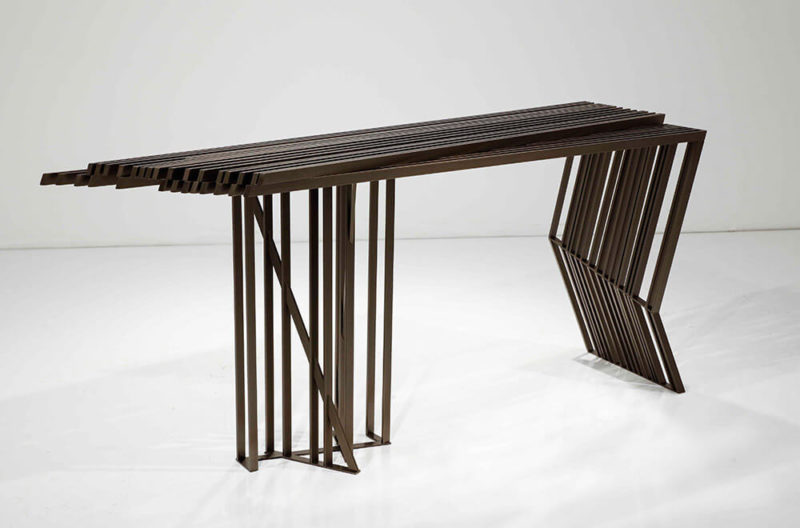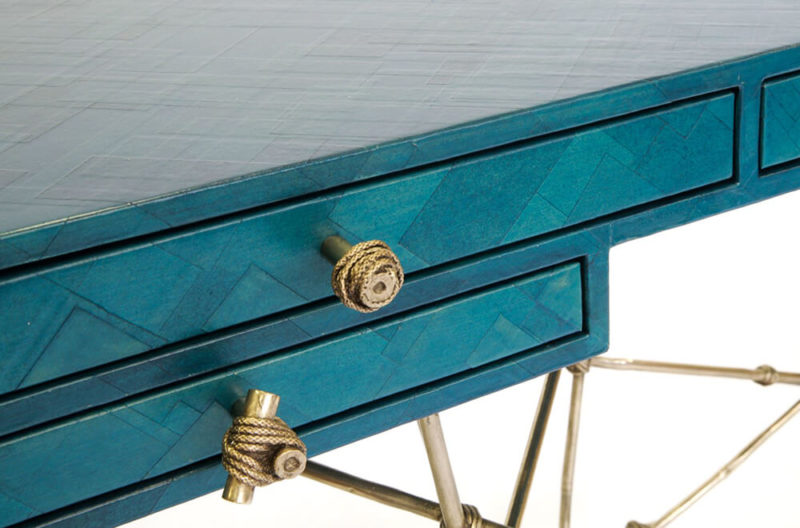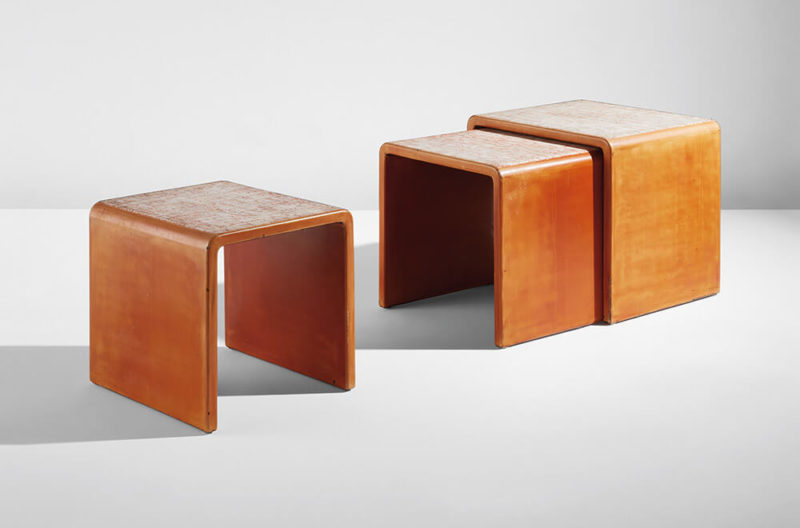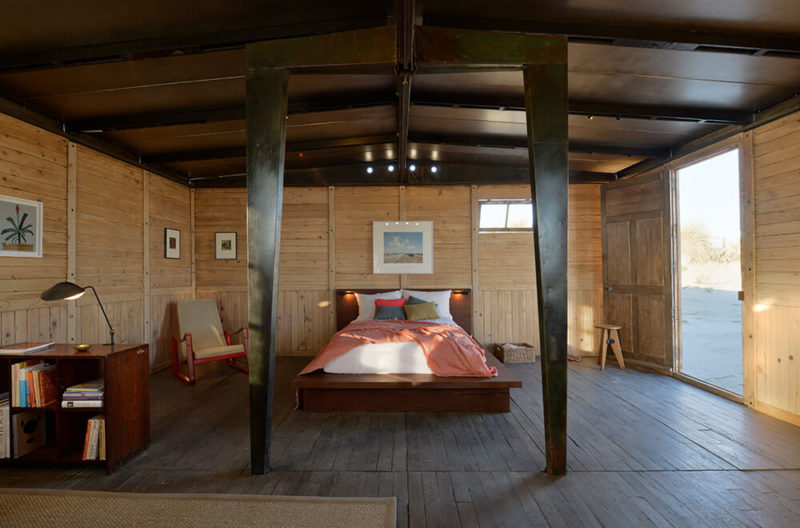ROUNDUP / European Summer Design Sales 2020
As auction houses have embraced the new world order of virtual tours and e-catalogues, before opening live sales this month, their clients have discovered a new appetite for history and provenance.

François-Xavier Lalanne, ‘Unique Famille Hippopotames’, 1992. (Estimate €2,000,000 – €2,500,000. Sold for €2,112,500.)
COURTESY: Sotheby’s
TREPIDATION ABOUT THE health of the design market was brushed aside at Sotheby’s Paris last week. The auction house’s post-lockdown sale on 25th June was buoyant, achieving a total of €11.2m, exceeding the €7m – 9.8m estimate. “I’m convinced that the confinement had an effect because people couldn’t buy or see things for several months,” Florent Jeanniard, senior director for Europe, says. “People were enthusiastic about seeing important works again, which is a very good sign for the future.”
François-Xavier Lalanne’s unique ‘Famille Hippopotames’ (1992), consisting of three patinated bronze hippopotamuses, their lids lifting to reveal a bathtub, a bidet and a loo, was the top ticket, fetching €2.1m (estimate €2m – 2.5m). Lalanne’s sculptural bronze rabbit, ‘Lapin à vent de TourTour’ (1998) reached €1.9m (estimate €1m – 1.5m) and Alberto Giacometti’s ‘Aigle Vase’, its upper part evoking an eagle’s head and wings, flew past its €400,000 – €600,000 estimate to €1.5m. These high points confirm the continuing popularity of Les Lalanne and Giacometti, whose work borders art and design.
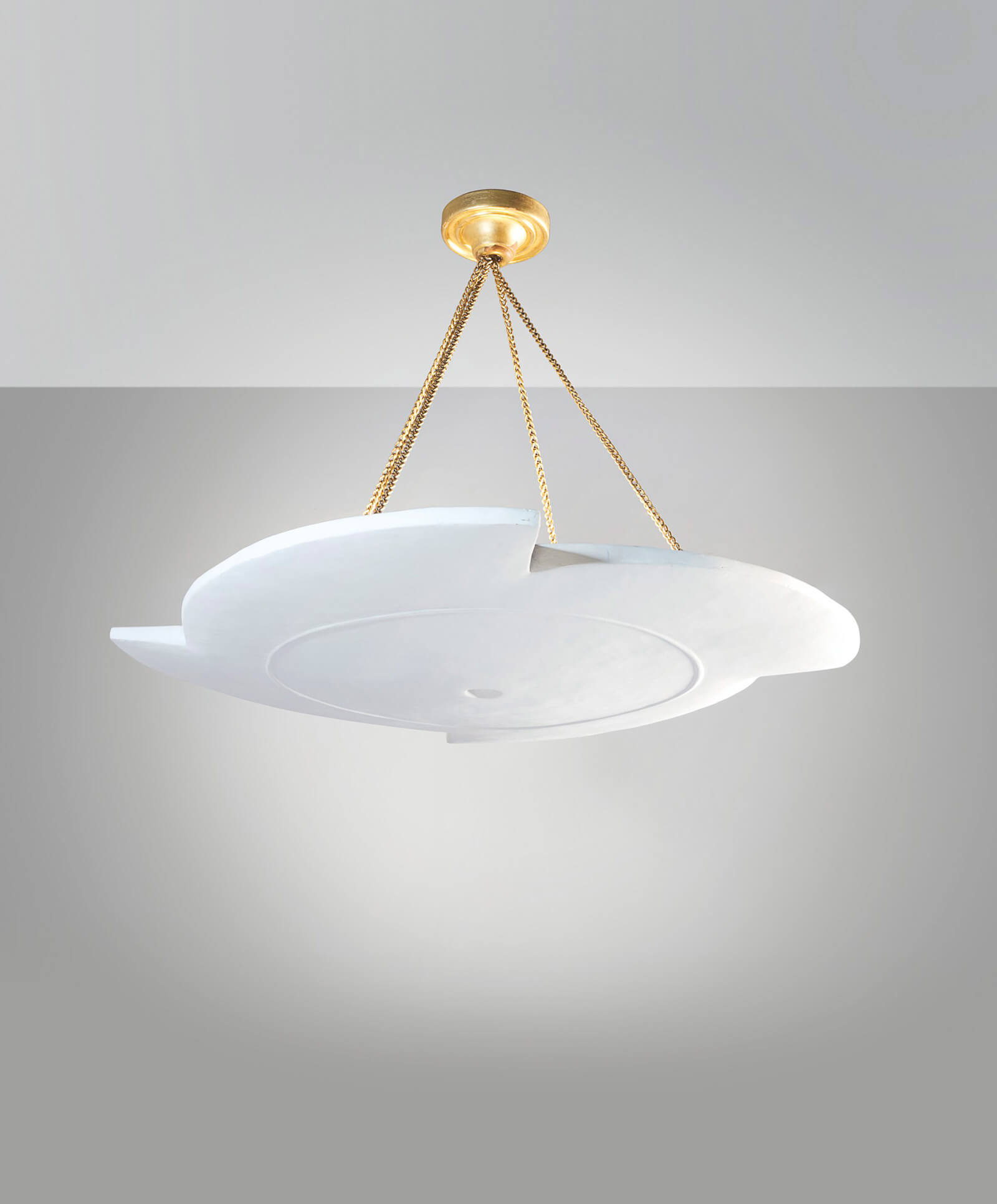
Alberto Giacometti, ‘Spiral’ suspended light, model created in 1933, executed in circa 1939.
(Estimate: €300,000 – €500,000, Sold for €550,000)
COURTESY: Christie’s
The sale benefitted from a curated presentation which saw design displayed alongside contemporary art and tribal art (those two sales were held the same week), evoking a collector’s home. “It’s like entering somebody’s house, with a lovely sofa by Jean-Michel Frank, a low table by Garouste and Bonetti, paintings by Hans Hartung and Zao Wou-Ki and a lamp by Alberto Giacometti,” Jeanniard says. During the weeks deprived of physical contact with art, Jeanniard believes that some collectors spent more time reading, learning and deepening their knowledge. He recalls that he spoke to one collector on the phone for two hours about the life and work of Diego Giacometti.
Asked about how the COVID-19 confinement has impacted its design sales strategy, Jeanniard refers to its Take a Seat online sale in April, which generated €284,000. It featured 49 lots of chairs, from 18th century designs to contemporary creations. “We launched the sale during lockdown – we already had the photos and it worked very well,” Jeanniard says. “We noticed that clients were requesting additional photos and more visual information. Previously, we’d put one or two photos on the internet, now people were asking for five or six from different angles.”
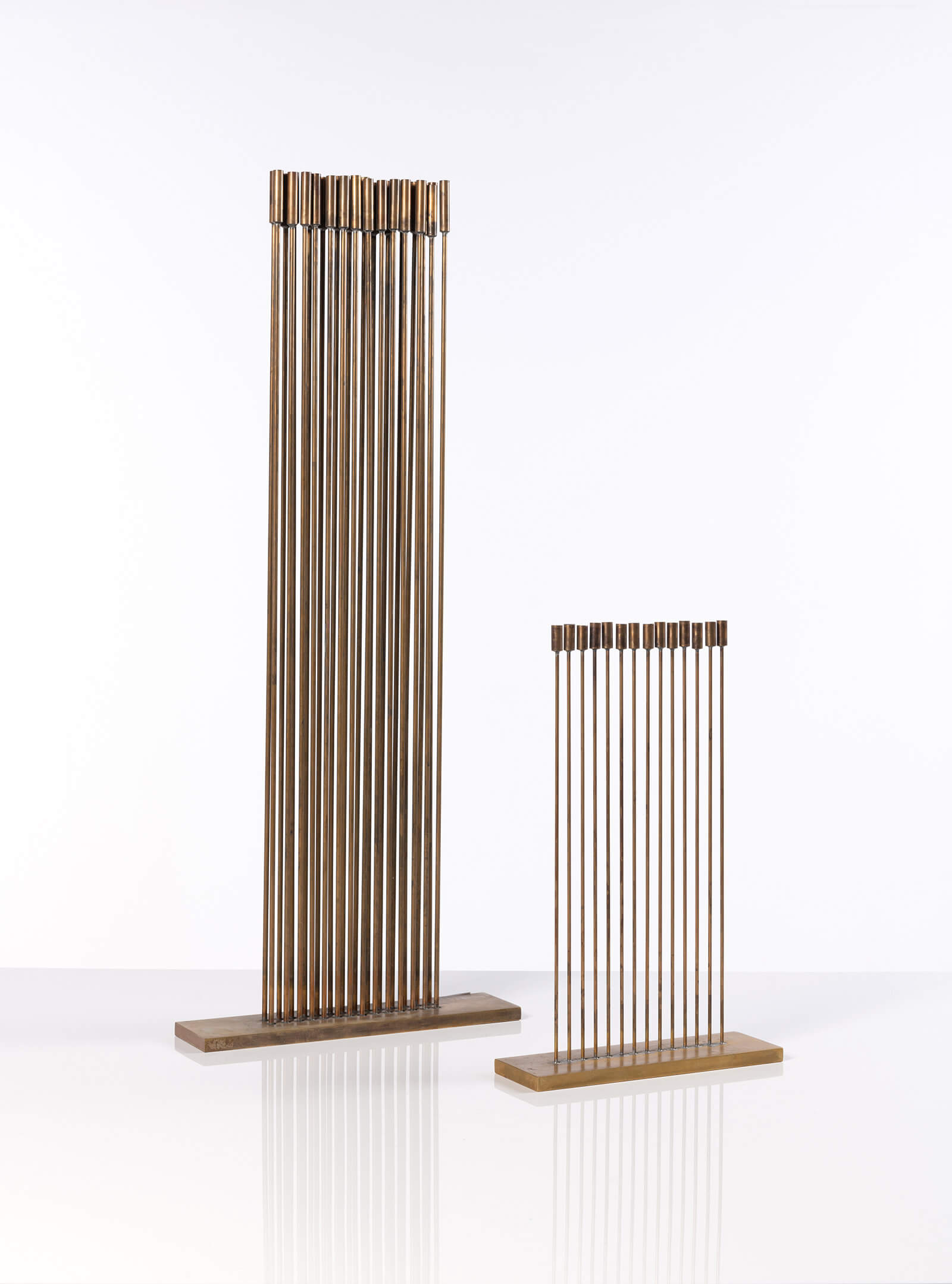
Harry Bertoia, ‘Sonambient series’, circa 1972. (Estimate €20,000 – €30,000)
COURTESY: Piasa
“During the weeks deprived of physical contact with art, some collectors spent more time reading, learning and deepening their knowledge …” Florent Jeanniard, Sotheby’s
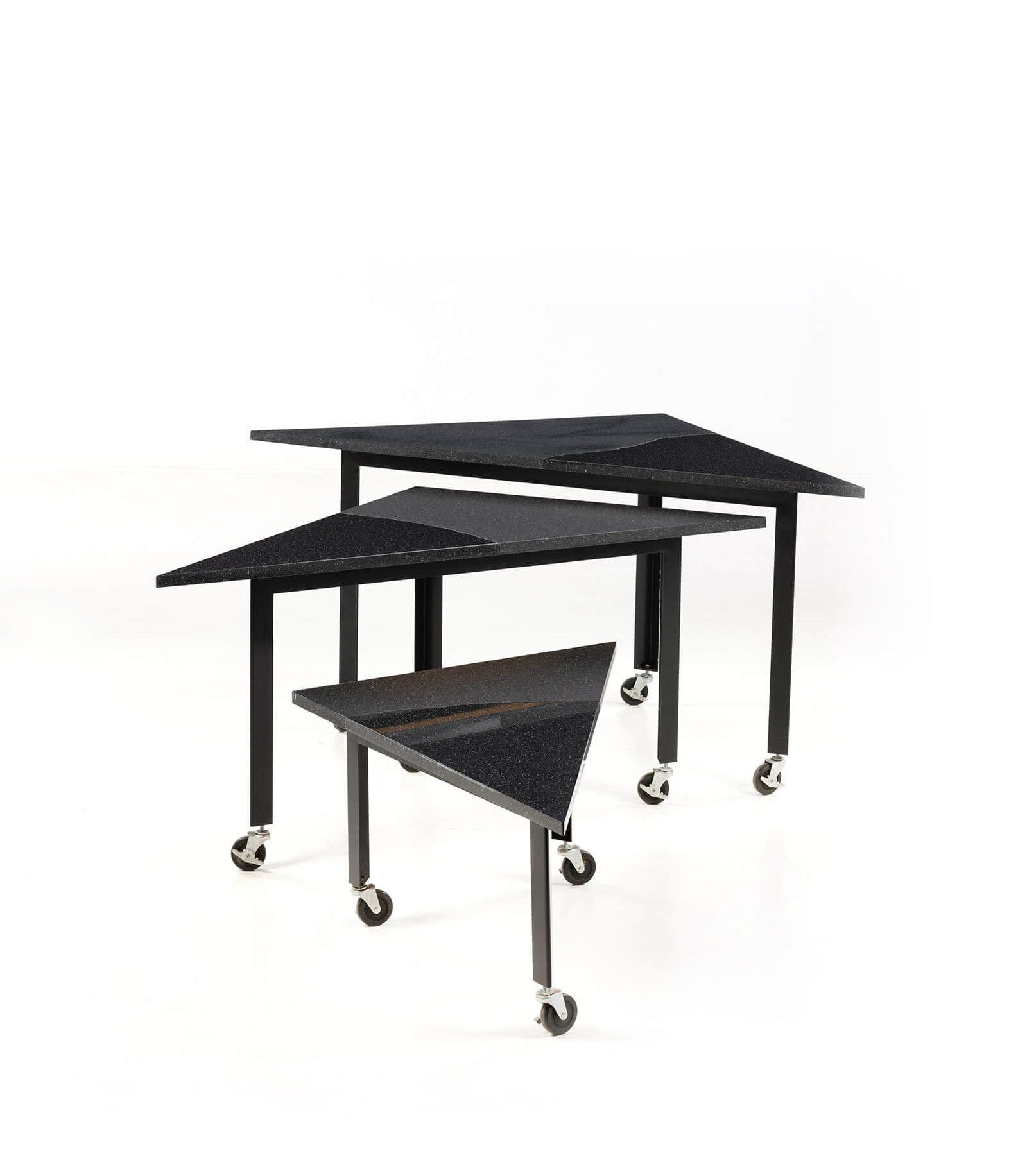
Rei Kawakubo, ‘Set of three nest tables’, 1985. (Estimate €5,000 – €7,000)
COURTESY: Piasa
“Under lockdown people were looking at their home environment and had a desire to improve it.” Domenico Raimondo, Phillips
This has inspired Sotheby’s to plan online ‘capsule’ sales from September onwards, which will focus on particular designers, movements or historical moments. These capsule sales will run between the live sales in November and May, and will not have printed catalogues. “When everyone was stuck at home, with the printers and post offices not working, we realised that paper catalogues are unnecessary,” Jeanniard explains, however, Sotheby’s will still produce them for the larger, live sales.
Phillips’s first post-lockdown design sale in London on 19th April also surpassed its £4m estimate, realising £5.3m. “I’ve never, ever had so much interest in a sale in my whole career and it sold 98% by value,” Domenico Raimondo, head of design for Europe, enthuses. “It might be that under lockdown people were looking at their home environment and had a desire to improve it.”
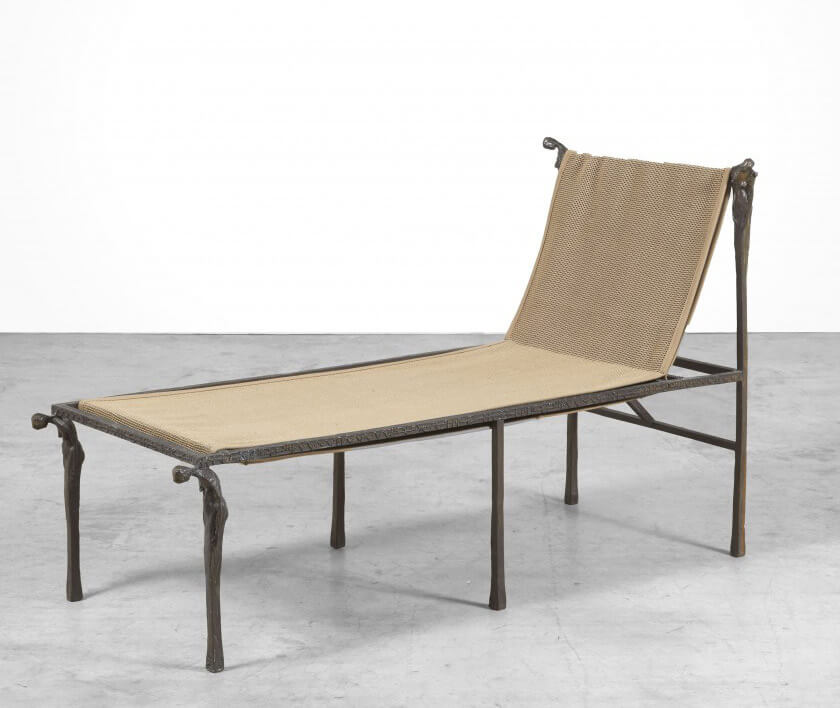
Ingrid Donat, ‘Aux Caryatides’, 1999. (Estimate €15,000 – €20,000; Sold for €26,000)
COURTESY: © Artcurial
The catalogue had come out in March, but the installation itself took place in April under social distancing conditions. “It took us almost two weeks to install it – rather than three days – but it was a very rewarding experience and nice atmosphere.”
The sale was led by a unique, low table with twisting bronze branches and tropical birds created in 1988 by Claude Lalanne, wife of François-Xavier Lalanne, which achieved £312,500. Shiro Kuramata’s poetic ‘Miss Blanche’ chair (designed in 1988, executed in 1991), with synthetic red roses encased in acrylic, was the second top-scoring lot, selling for £250,000. A surprising triumph was an architectural desk from around 1945 that Mario Gottardi made for a lawyer: it skyrocketed past its £10,000 – £15,000 estimate to £91,250.

Mario Gottardi, ‘Desk’ designed for a lawyer’s office, circa 1945. (Estimate £10,000 – £15,000. Sold for £91,250)
COURTESY: Phillips
The cancellation of the art and design fairs could be giving auction houses a competitive advantage, Raimondo opines, “One client said to me: ‘It’s good because as none of the fairs were happening, I could really concentrate on your auction.’”
For Raimondo, the keyword for London’s deconfinement is ‘adaptability’. As he says, “We managed to create a virtual salesroom which enabled some people [who couldn’t attend in person] to have virtual tours.”
Like Sotheby’s, Phillips is planning more online sales. “Online is something we were already working on and this [pandemic] has only accelerated [our recognition of] how it’s part of the future,” Raimondo remarks. Flavien Gaillard, head of design at Christie’s Paris, anticipates that the volume of online sales will be increasing across the board, which means that photo quality needs to be excellent. “Clients browse catalogues very fast, so photos must catch people’s eye on the first click,” he says.
Christie’s is also going to stop publishing printed catalogues except for “important collections.” It plans to complement live sales in Paris, London and New York with online sales and work on thematic sales with other departments. Creating a salon d’art ambience, its 30th June design sale is being co-presented with tribal art and post-war and contemporary art. Underlying this is a desire to reposition the perception of design. “Today, I don’t sell design – I sell furniture as an artwork,” Gaillard insists. “A chair can no longer be sold as something utilitarian to sit on, but as a sculpture.”
Comprising 118 lots, the sale is estimated to generate nearly €5m. A focus is shone on 19 lots by Jean Royère that were commissioned in 1962, including a ‘Liane’ wall work with six lights hanging on ivy-like vines (estimate: €400,000 – €600,000) and a sumptuous, dark orange ‘Ours Polaire’ (polar bear) sofa (estimate: €300,000 – €500,000). “These emblematic Royère pieces were commissioned by a French interior designer, now 92, and they have remained with the same owner in their original condition, so they’re fresh to the market,” Gaillard explains.

Jean Royère, ‘Ours Polaire’ sofa, model created in 1947, executed 1962. (Estimate €300,000 – €500,000; Sold for €1,090,000)
COURTESY: Christie’s
Despite being confident about the market, Gaillard anticipates that some collectors may be less adventurous with their acquisitions: “COVID-19 hasn’t changed the prices, demand and interest. But I think some collectors will turn to big names for safety, and concentrate on five of the top ten names in each discipline.”
Among other standouts are Claude Lalanne’s bed, 2004, with an owl perching over sinuous branches (estimate: €200,000 – €300,000), Alberto Giacometti’s ‘Spiral’ ceiling lamp (estimate: €300,000 – €500,000), Ado Chale’s ‘Solune’ low table (2010) made from gleaming gilt bronze and cast aluminium forms (estimate: €50,000 – €70,000) and Maria Pergay’s ‘Bord Flammes’ table bordered with steel flickering flames, circa 1957, (€30,000 – €50,000). There’s also a bicycle (estimate: €40,000 – €60,000) that Jean Prouvé designed in 1941 so his employees could cycle to his workshops. The design was never industrialised so fewer than ten were made – one of which is in the Centre Pompidou’s collection.
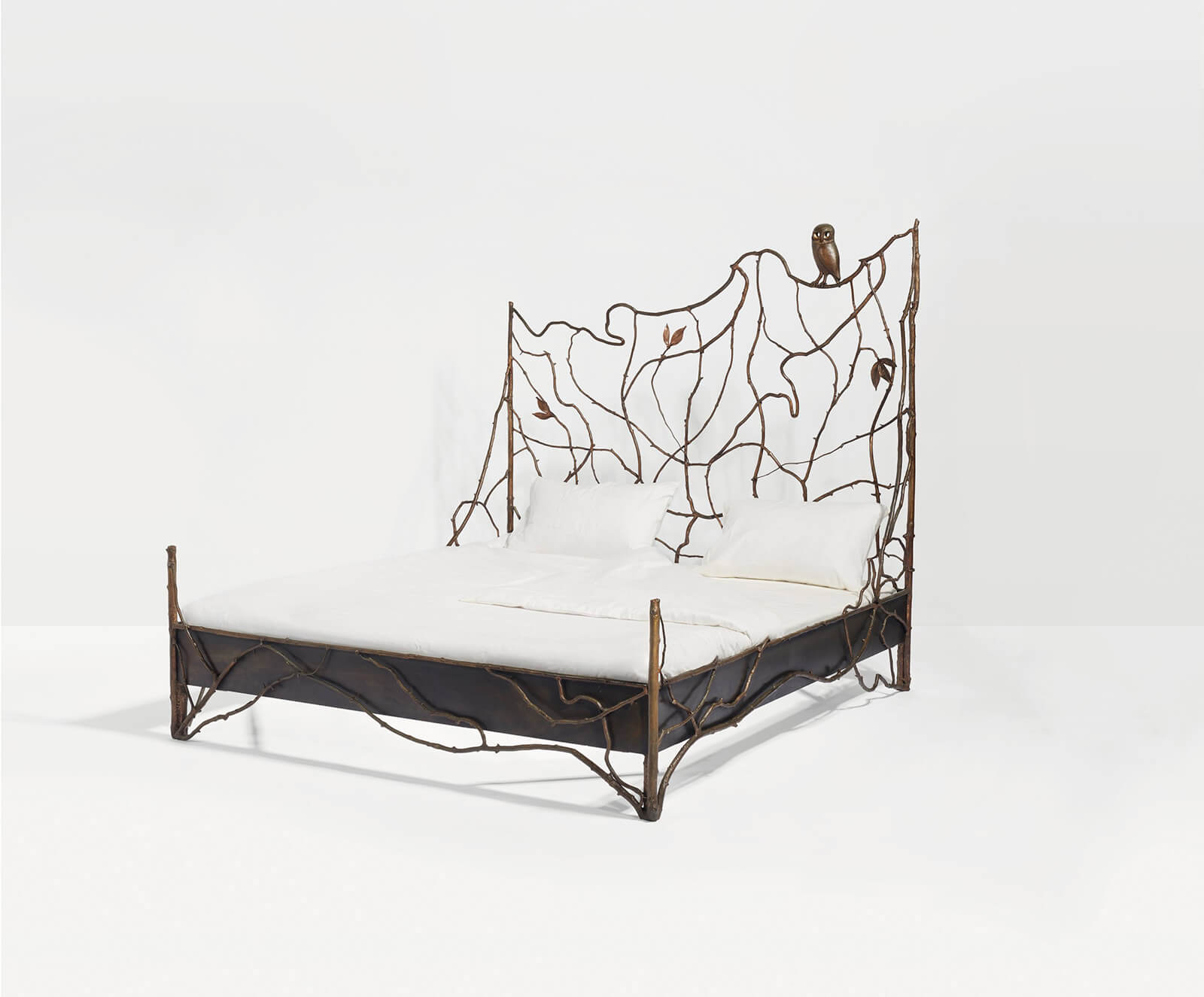
Claude Lalanne, ‘Bed with Branches and Owl’, 2004. (Estimate €200,000 – €300,000; SOLD for €490,000)
COURTESY: Christie’s
Artcurial in Paris is gearing up for three sales on 1st – 2nd July: European Design Collection, Art Deco, and Scandinavian Design. Poul Henningsen’s ‘Grand Piano’, 1931 (estimate: €100 000 – €150 000) impresses in the Scandinavian sale. With its curving steel legs and plexiglass lid, it’s a modernist gem. Only a few models were produced, such as one for Alvar Aalto’s Villa Mairea in Finland and another at Copenhagen’s Design Museum.
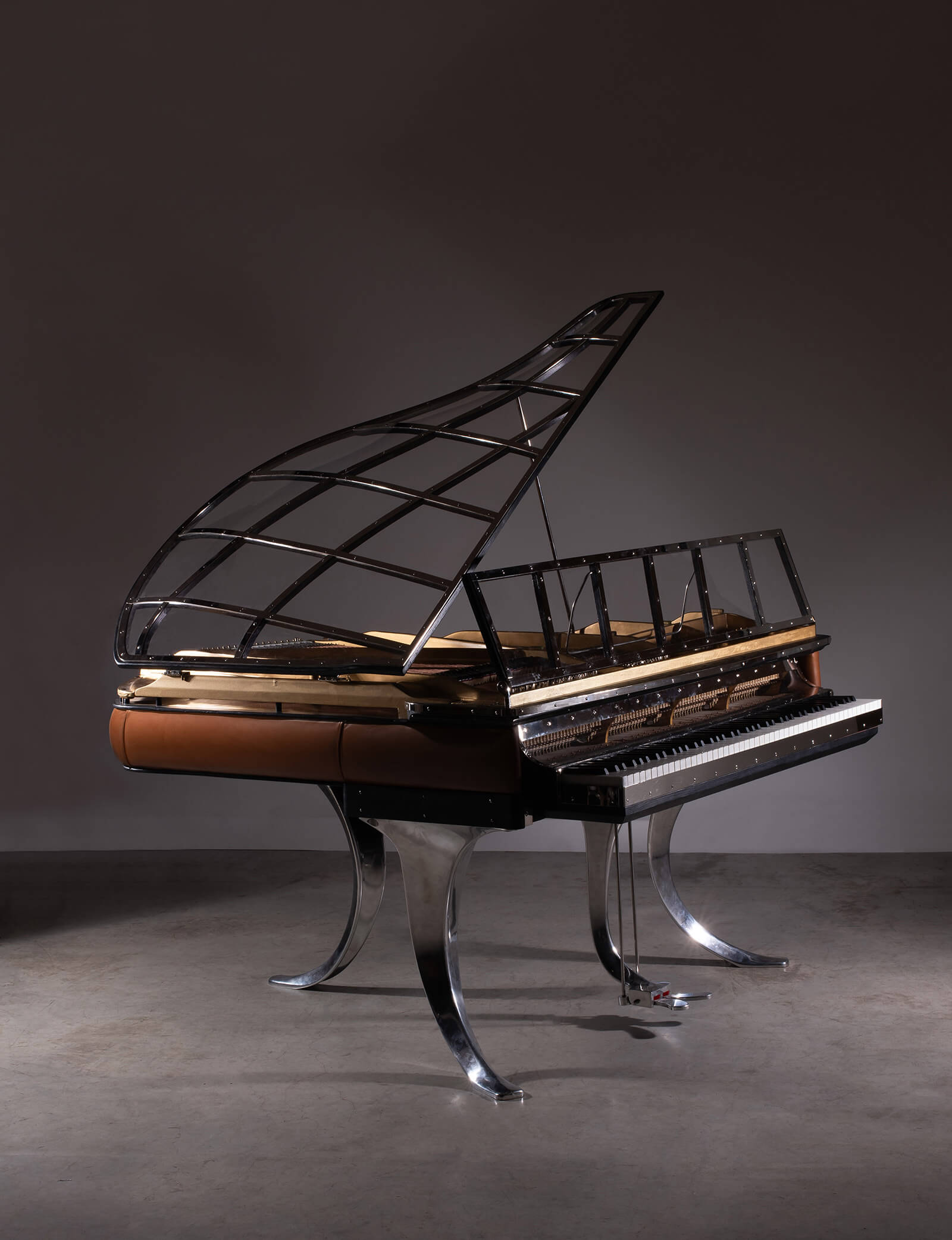
Poul Henningsen, ‘Grand Piano’,1931. (Estimate €100,000 – €150,000; SOLD for €130,000)
COURTESY: © Artcurial
Paavo Tynell’s ‘Snowflake Number 1’ ceiling lamp (1947), model 9014, with 96 perforated metal snowflakes, is also a marvel. Estimated at €120,000 – €150,000, it is from the 1947 Fantasia series for Taito Oy. Another rare piece is a red armchair that Märta Blomstedt designed in 1938 for a Finnish hotel (estimate: €60,000 – €80,000).
Besides works by Gio Ponti, the other sales include Pierre Legrain’s ‘Sofa-podium’, 1923, (estimate: €150,000 – €200,000), Ingrid Donat’s ‘Aux Caryatides’ elegant daybed (1999), with four bronze caryatid legs (estimate: €15,000 – €20,000) and Duilio Barnabé and Fontana Arte’s ‘Cabinet’ bar, 1960, with pictorially painted dark turquoise glass doors (estimate: €10,000 – €15,000).

Duilio Barnabé and Fontana Arte, ‘Cabinet bar’, 1960. (Estimate €10,000 – €15,000; Unsold)
COURTESY: © Artcurial
Transport difficulties, however, have forced Artcurial to delay its Italian Design sale to September. “Several things have been postponed which will obviously have an impact on our overall turnover, but I don’t think there’ll be an impact on the prices obtained for each individual lot,” Sabrina Dolla, Artcurial’s decorative arts specialist, says.
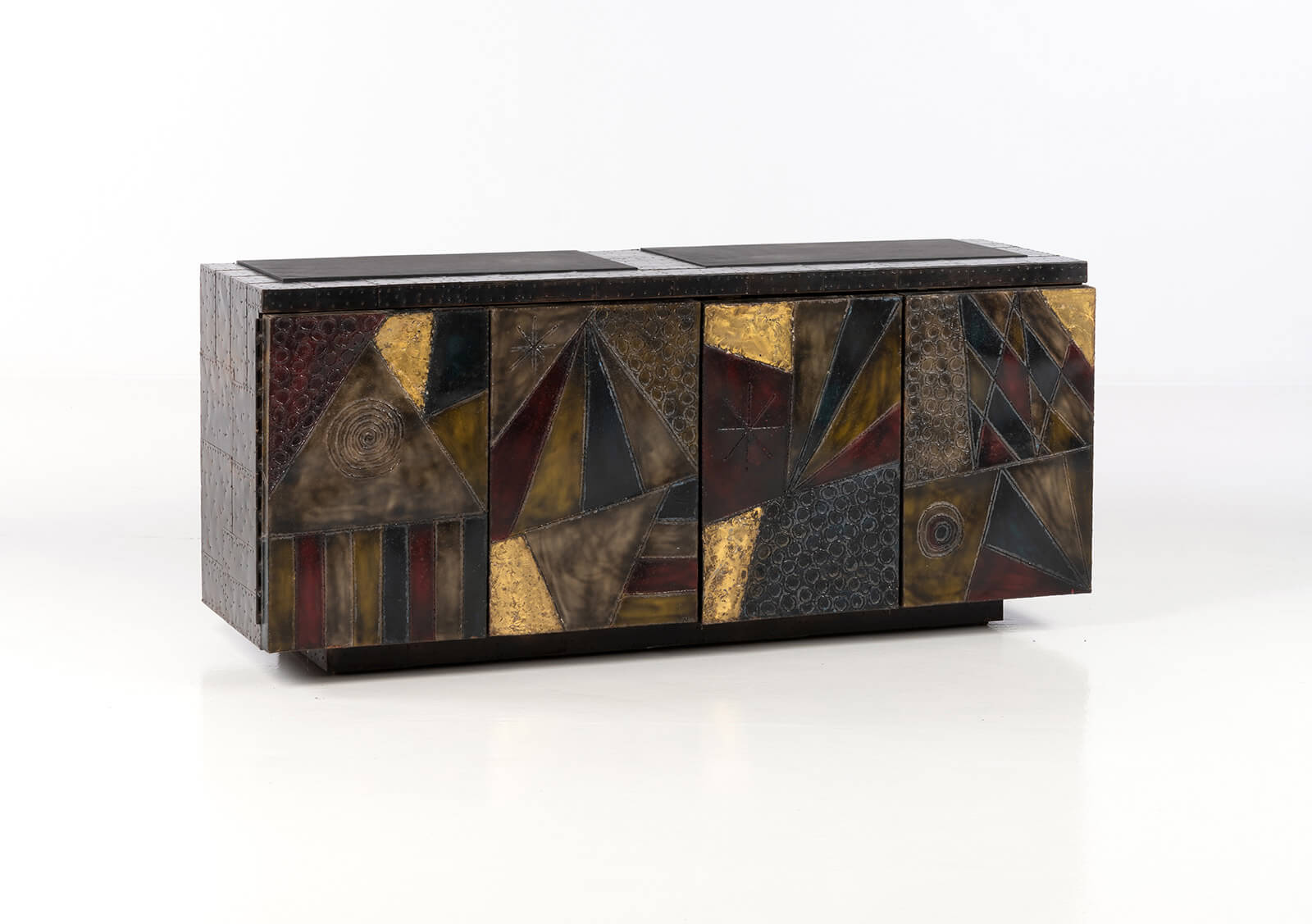
Paul Evans, ‘Model PE-40 A – Unique piece’ sideboard, 1965. (Estimate €20,000 – €30,000)
COURTESY: Piasa
Dolla concedes that the COVID-19 pandemic has induced collectors to “look more closely at the history of objects and designers, not clutter themselves with useless things, and to buy less but better.” She adds: “The pandemic also made us realise that although we must continue developing online-only sales to attract a younger generation, we need [to be scrupulous] about how and when we do them.”
Piasa in Paris is launching a new digital strategy in the autumn. “We were one of the precursors with online sales and now is the moment to elaborate a whole new system,” Frédéric Chambre, Piasa’s executive director and head of design, says.
“The beginning of post-COVID activity has been positive”, he reports. Indeed, at Piasa’s design auction on 28th May (originally planned for 25th March), which included 72 lots by Alvar Aalto, Alto’s unique ‘Tea Trolley 900’ (edited by Huonekalu-ja Rakennustyötehdas Oy/Artek in circa 1955) soared past its €6,000 – €9,000 estimate to €50,700.
Yet, after months spent working from home, Chambre is eager to start travelling again to meet clients: “It’s a trade where we need human relationships to talk about artworks and collections. It’s far easier to share ideas in person than by doing Zoom meetings or conference calls.”
An American/Brazilian/Japanese sale on 2nd July offers an eclectic assortment of 197 lots, including numerous pieces by Isamu Noguchi and Terence Harold Robsjohn-Gibbings. Joaquim Tenreiro’s ‘Cadeira de tres pès’ tripod chair, 1947, made from various woods (estimate: €125,000 – €150,000), Paul Evans’s ‘Patchwork’ wall shelf, 1965, combining steel, copper, brass and slate shapes (€8,000 – €12,000) and Philip and Kelvin LaVerne’s ‘Eternal Forest’ table (1960) – the hand-cut, bronze-over-pewter top revealing an intricate design of trees (estimate: €15,000 – €20,000) – exemplify exquisite craftsmanship. So, too, does Michele Oka Doner’s sculptural bronze chair, 1991 (estimate: €15,000 – €20,000).

Joaquim Tenreiro, ‘Cadeira de tres pès’, 1947. (Estimate €125,000 – €150, 000)
COURTESY: Piasa
In line with the other auction houses, the ambition in each presentation is to reinforce the idea that design is akin to art. “We sit on art, we have dinner on art, we have lighting that’s art and we have art on the walls,” Chambre adds. It is a strategy that seems to be working.
Sotheby’s Important Design – 25th June 2020.
Phillips Design Auction – London 19th June 2020.
Christie’s Design – 30th June 2020.
Artcurial – 1st and 2nd July 2020.
Piasa – 2nd July 2020.




